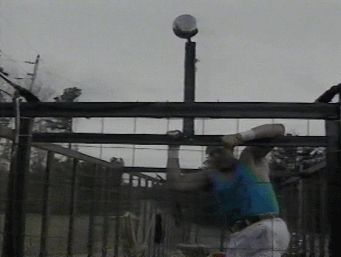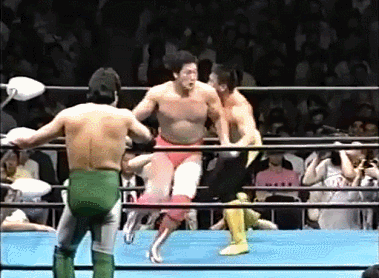This was part of a commission over at www.ko-fi.com/elhijodelsimon from reader Bren, who just requested five of the worst matches I’d ever seen. Given that many of them have already been covered (every HHH/Shawn match, the 2015 Royal Rumble), or will be covered (there are many in 2016!) in the future, I wanted to try and make it a little interesting. So while not exactly the five WORST, I chose five matches that I really really hate, dropping over the next several days.
First up, it’s the only ever KING OF THE ROAD match, conducted on the bed(s) of a moving truck. The winner is the first man to ring a bell near the back of the truck.
Obviously, this fucking sucks.
It’s one of the stupidest ideas in the history of wrestling, and a clear waste of an all-time talent in one of his peaks in Dustin Rhodes. Beyond that, it’s also a perfect representation of one of the more frustrating and upsetting things in wrestling history, which is the advent of Hoganism in WCW in 1994 and 1995.
I can’t tell you how it felt to experience it in real time. I was four and five years old.
However, I have watched it all of the way through. When I graduated college at the end of 2015, I was kind of adrift, as many are. To fill time while trying to find a real (“real”) job, I undertook a gigantic project to watch as much WCW as possible from start to finish, with start being January 1985 on (as 1985 was when they got the Saturday Night spot, and it largely became what people think of when saying “WCW/NWA”). As I write this in late November 2021, I’m close to finishing 1998. You can follow that entire journey here, as I think a forum is the ideal place for such a project, but I say all of that to say that I’ve come as close to experiencing it in real time as one could nearly twenty years after the fact. By watching everything, I not only gave myself context for so many things that happened, but also largely immersed myself in the company during the years I was covering.
Which is to say that, having built up quite the affection for WCW and what it was and what it could be and what it was on the border of being in early to mid 1994, it is one of the great heartbreakers in wrestling history what Hulk Hogan and his pals all did in the back half of 1994 and through mid 1996 before the company finally turned itself entirely around.
One of the best rosters ever assembled (Flair, Steamboat, Arn, Foley, Austin, Pillman, Rude, Regal, Sting, Vader, Dustin, etc.) got slowly torn apart and replaced with absolute duds. It’s the most brutal and nasty hostile takeover I’ve ever seen in wrestling. The stuff that makes 2010 TNA look almost subtle. The ascents of virtually everyone WCW had spent the previous three years building from the ground up into near main eventers were all cut off in different ways, and while Dustin never had to lose in a minute to Jim Duggan or got ran out because of a Dave Sullivan feud or anything like that, what happened to him over the previous six months and here is one of the shittier things in wrestling history.
Hot off of the great 1994 War Games that, while imperfect (Dusty Rhodes wins WG, and not Dustin, who the feud was about), also gave Dustin Rhodes the win in a twelve month long program, Dustin was ready to go. The dictionary definition of a guy just waiting to get pay-per-view main events and a World title shot and maybe reign, even having one of the great WCW matches ever against WCW’s top heel at the end of the year. Only, then WCW gave poor Barry Darsow this gimmick of a heckling fan truck driver who Col. Parker gave money to get trained, and he was then booked to come out on the positive side of a feud with Dustin in an all-time loser piece of booking.
The culmination is here, with not only a match that is a truly unwinnable scenario, but one that also costs both men their jobs through no fault of their own.
Firstly, the match.

At one point, Tony Schiavone states that the truck is going 55 miles an hour, but says this in a way that sort of implies that it’s like a SPEED situation where it always has to be going 55 miles per hour. Also, as one can see, it’s a livestock style truck, with bales of hay and the cage fencing. That might at least lead to some nasty bumps, but the hay is also on the floor of the truck bed, so while the match seems like the set up for some action movie shit, it doesn’t even get to be properly violent. The match was taped five days before the pay-per-view aired and according to the Wrestling Observer at the time, was twenty minutes. Reportedly, it was good. However, this is cut down to thirteen minutes and shown with some horrible camera angles and editing choices to try and not show either man bleeding, and the entire production is a true god damned disaster. The camera work combined with the match set up makes it impossible for anything in the match to even stand out as especially brutal, interesting, or cool.
They have no shortcuts in there except for one bucket, so they’re wobbling around and trying to walk forward and throwing each other lightly into a cage on a moving truck for thirteen goddamned minutes before Bully rings the bell to win.
The match is also infuriating because of everything around it.
When it was being taped, agent Mike Graham told them both that bleeding was okay despite WCW’s rules against it, and even reportedly brought them blades to use beforehand. Both men were then fired for bleeding, despite a.) it being taped days in advance, so they could have NOT done that & b.) someone in management not only explicitly telling them it was okay, but bringing them the tools. All happening at a time when not only was WCW trying to drive away older fans in favor of those theoretical newer casuals that Hogan was bringing in, but also under pressure to cut costs.
It’s genuinely unbelievable, even from WCW, and one of the bigger examples of guys just blatantly being fucked over in wrestling history.
Forget Dustin being minimized for months before this. What I can’t get away from is that bit about TBS wanting to cut costs a lot around this point, and how anyone in management really should have known better, and how the guys themselves even had questions about it. Darsow was on a short term deal, but Dustin…man. I know that I am prone to conspiracy theories, but this is a hard one to shake, especially with Dustin Rhodes as a well liked young babyface very emblematic of a previous regime, and without the greatest relationship with his dad that might have saved his ass otherwise. Mike Graham is a KNOWN Dusty Rhodes stooge and found his way back to WCW eventually, which fits right in with how a patsy ass fall guy would be treated here. The other guy of the three who gets fired is an old guy whose contract was already a short term one due to expire soon.
I don’t know, it’s a whole lot too convenient.
WCW enforces a rule that Hulk Hogan had already broken on the last pay per view, and does it at the expense of someone they already had been trying to phase out for the last six months. It also happens after Dustin’s second loss in a row to this failing gimmick, in a match he loses cleanly, and it’s such an obviously bad idea that nobody could have ever thought this would actually be good. So the firing is obviously known to be insane, but nobody’s TOO mad because of how awful this entire production actually was.
The only counterweight is that WCW is too disorganized to believably pull off a political hit this well, but I don’t know, man. Again, looking at it and reading about it sends about a hundred different alarm bells firing off. It’s all a little too fortuitous for the company for me to believe this wasn’t always a set up. If it smells like shit and looks like shit, it’s probably shit.
One of the more disgusting and worst things in WCW history, match and all, and that’s some very fertile ground.
At least if it was a plot, it wouldn’t be the first time Dusty Rhodes used a vehicle to sabotage a hot young babyface!



